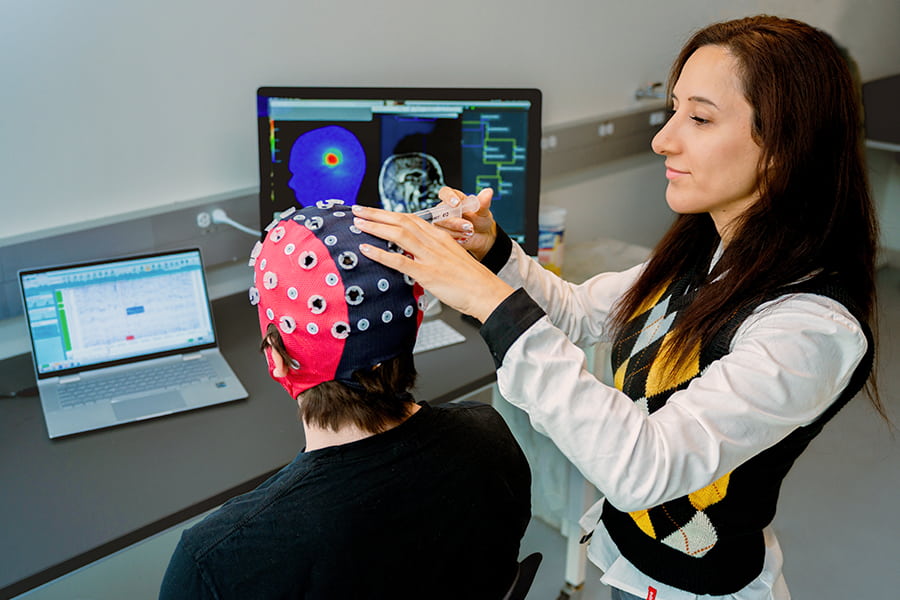- Home
- News
- Recent News
- The Brain Stimulation and Simulation Lab
The Brain Stimulation and Simulation Lab
Cognitive deficits associated with aging and neurodegenerative diseases pose major challenges to health care around the world.

Nearly 46 million people worldwide suffered from dementia in 2015, with this number estimated to reach 115 million in 2050*. This points to a growing need for efficacious therapeutics to mitigate cognitive decline and effective methods for early detection of neurodegeneration. In the Brain Stimulation and Simulation Lab, we combine physics, neuroscience, and biomedical engineering to investigate new diagnostic and treatment methods for neuropathologies across the life span.
In our lab, we use electromagnetic brain stimulation to temporarily change the activity of neurons, which can improve memory, executive, and motor function. These methods are safe, cheap, and have few side effects, but the effects are short-lived. Through computational modeling and neuroscientific experimentation, we try to understand and improve how brain stimulation works. The first step in our studies is to make a magnetic resonance imaging (MRI) scan of a study participant. We use this scan to build a computer model of the head and all the tissues within. With this model, we can calculate the electric fields induced in the brain by stimulation applied to the scalp. After identifying which brain regions to target on the MRI scan, we use the model to find the electrode placement that optimally delivers current to those regions.

From MRI scans, we build computational head models that we then use to calculate the electric fields induced in the brain by stimulation applied through electrodes on the scalp. Image By: Sumientra Rampersad
At this point, our research transfers from computational to experimental. We bring the participant to the lab for participation in a clinical trial. Before and after receiving five days of brain stimulation, they complete a series of cognitive tests and scans. Differences in performance between the two sessions demonstrate the effects of stimulation. We recently completed a clinical trial with three different stimulation groups and a placebo group to investigate the role of motivation in memory function. The results of this study may open a new avenue toward prevention and treatment of dementia with safe and targeted noninvasive brain stimulation.
The prospects of successful treatment are dramatically improved when decline is detected early. Currently, the effectiveness of neuropsychological assessments is thwarted by low sensitivity, sporadicity, and subjective reports. Our lab is developing a smartphone app that estimates changes in cognitive function from information such as app use, typing speed, and location data. By comparing this data to existing models, the app can detect and predict cognitive decline before users notice the changes themselves. In an initial study, we acquired lab testing and app data for one year to construct the models, and we are planning multi-year follow-up studies to finalize the app. Success of our app would transform current approaches to monitoring cognitive function and augment existing clinical assessments, paving the way to earlier, more accurate, and individualized therapies.
Our lab welcomes students of all levels, high school through PhD, and all majors, as research assistants. Students interested in medical imaging or computational work are taught basic neuroanatomy and learn how to construct MRI-based head models that will be used in our studies. Students wishing to do experimental work learn how to perform MRI, electroencephalography (EEG), cognitive and motor tests, and how to apply brain stimulation. They then independently perform experiments for one or more of our studies. If interested, please reach out.
* Source: Prince, M. World Alzheimer Report 2015: the global impact of dementia: an analysis of prevalence, incidence, cost and trends.

Assistant Professor of Physics